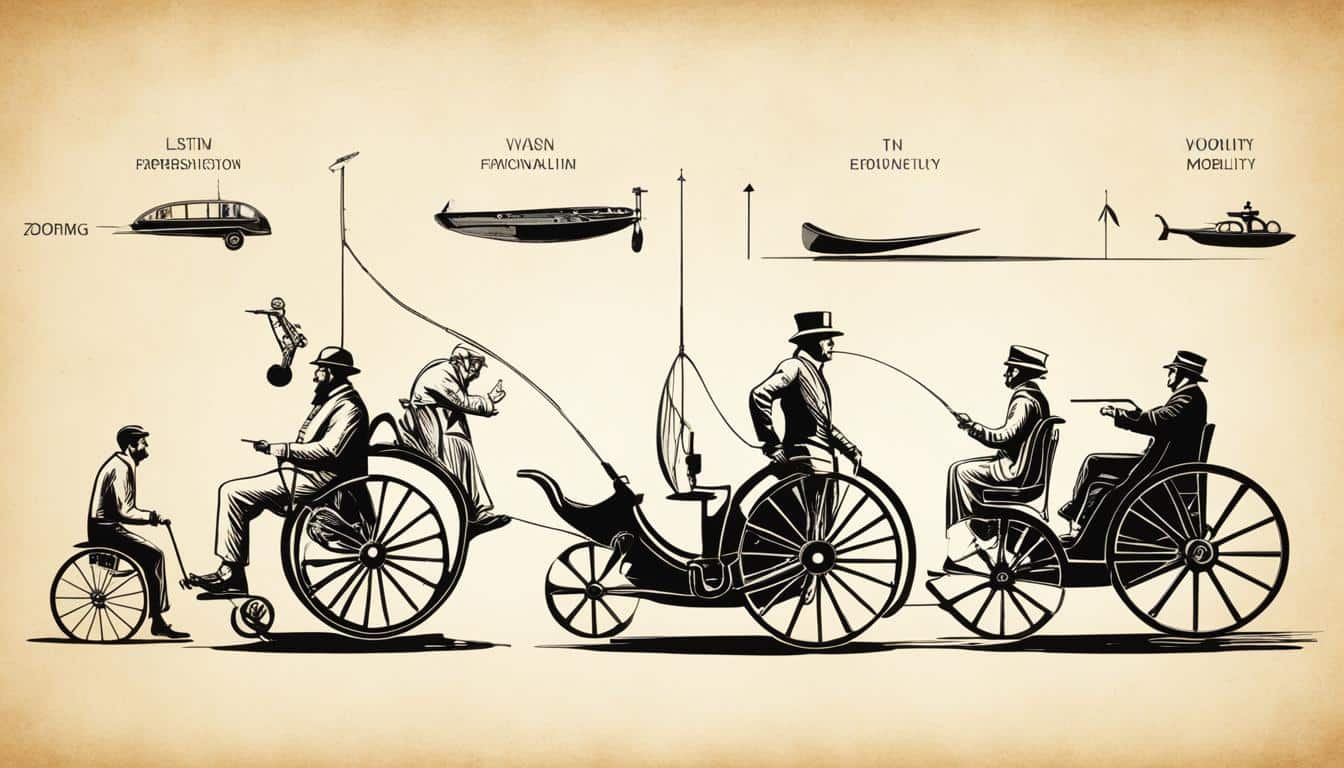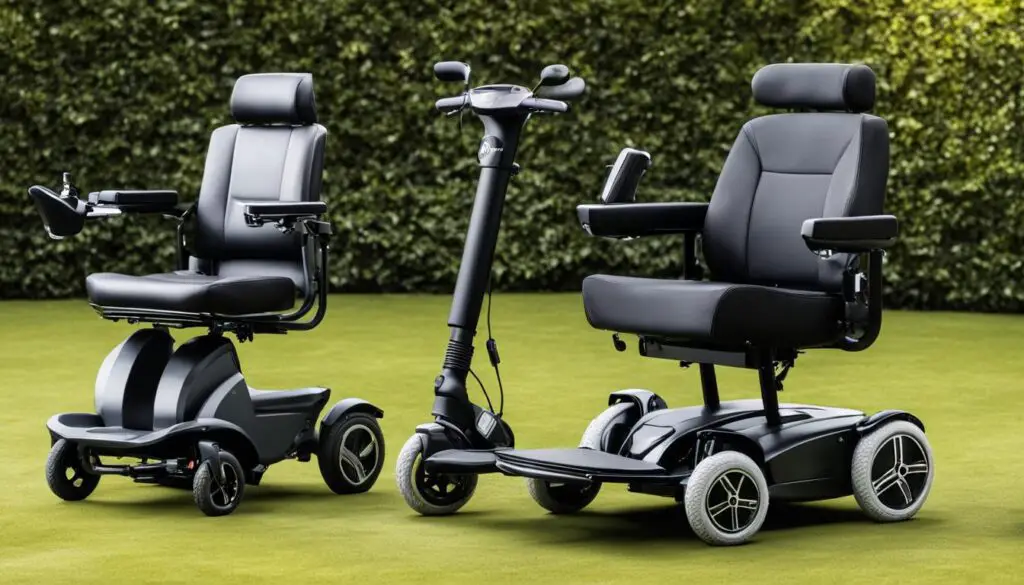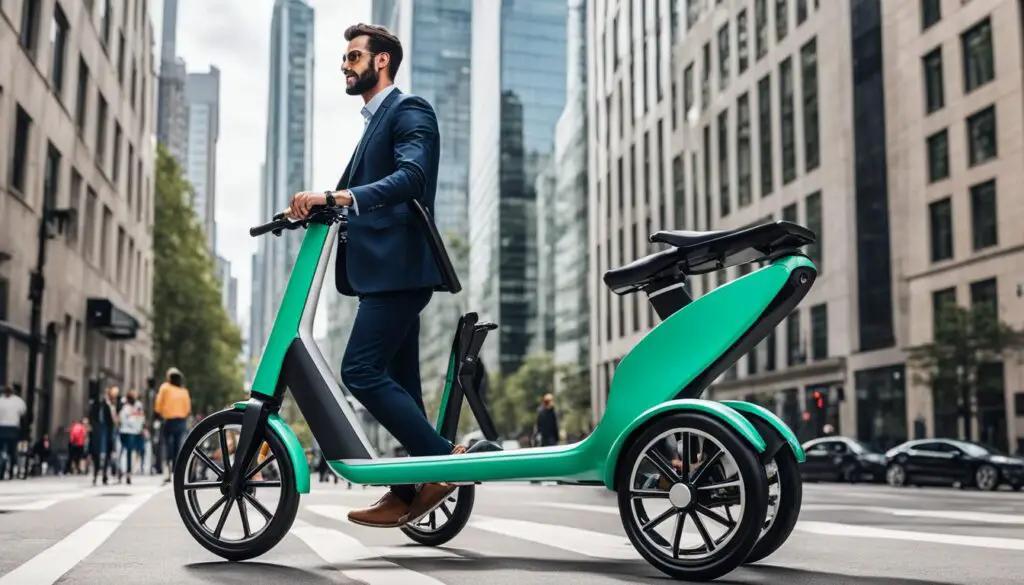
The Evolution of Personal Mobility Devices
I am excited to delve into the fascinating world of personal mobility devices. Over the years, these devices have undergone a remarkable evolution, revolutionizing the way we travel and bringing newfound freedom to individuals with mobility challenges. From the early days of simple aids to the cutting-edge technology shaping travel today, personal mobility devices have come a long way.
With advancements in travel technology, personal mobility devices have become more than just a means of transportation. They provide convenience, accessibility, and independence to those navigating the world with mobility limitations. Join me as we explore the journey of personal mobility devices, from their humble beginnings to the innovative solutions available today.
Key Takeaways:
- Personal mobility devices have undergone a significant evolution, transforming the way individuals with mobility challenges travel.
- Advancements in travel technology have led to the development of innovative solutions for improved accessibility and independence.
- From simple aids to motorized and smart mobility devices, personal mobility technology continues to advance.
- These devices provide convenience, range, speed, maneuverability, and integration with other smart devices and transportation systems.
- As technology progresses, we can anticipate further innovations in personal mobility devices, making travel more inclusive for all.
The Early Days of Personal Mobility Devices
In the early days, personal mobility devices were simple and rudimentary. Canes, crutches, and walking sticks were the primary aids used by people with mobility limitations. These devices provided basic support and stability but offered limited mobility.
Over time, advancements were made, leading to the development of wheelchairs, which revolutionized personal mobility for individuals with disabilities. Manual wheelchairs, powered by human effort, became a popular mode of transportation for those with limited mobility.
As the demand for improved mobility aids grew, innovators and inventors began refining and enhancing manual wheelchairs. Folding mechanisms were introduced to make them more portable, allowing for easier storage and transportation. The addition of larger rear wheels improved maneuverability and made it easier for users to navigate various terrains.
During this period, crutches and canes continued to be used alongside wheelchairs, offering support and stability to individuals who had sufficient upper body strength and mobility. These mobility aids played a vital role in early personal mobility, providing individuals with a sense of independence and freedom.
“Innovations in personal mobility devices have come a long way since the early days. From simple canes and walking sticks to manual wheelchairs, these aids laid the foundation for the mobility devices we use today.” – Dr. Joseph Ramirez, mobility aid specialist
The invention of the wheelchair marked a significant milestone in the history of personal mobility devices. It not only empowered individuals with limited mobility but also paved the way for further advancements in the field. As technology continued to evolve, the next chapter in the evolution of personal mobility would see the rise of motorized mobility devices.
The Evolution of Manual Wheelchairs
| Period | Advancements |
|---|---|
| 1800s | Introduction of folding mechanisms |
| 1900s | Incorporation of larger rear wheels for improved maneuverability |
The Rise of Motorized Mobility Devices
The advent of motorized mobility devices has revolutionized personal mobility, providing individuals with disabilities enhanced independence and freedom. Electric wheelchairs and scooters have emerged as game-changers in the field, offering increased mobility and accessibility compared to their manual counterparts.
Powered by batteries, electric wheelchairs and scooters provide a range of benefits. They offer improved maneuverability, allowing individuals to navigate various terrains more easily. These devices also boast increased speed, enabling users to travel longer distances in a shorter amount of time.
Furthermore, motorized mobility devices have incorporated advanced features to enhance the user’s experience. Adjustable seating positions provide comfort and support, while suspension systems offer a smoother ride, reducing impacts on the user’s body. Battery life has also improved, allowing for longer journeys without the need for frequent recharging.
“Electric wheelchairs and scooters have transformed my life. They have given me the freedom to explore the world independently, without relying on others for assistance.” – Jane Smith, electric wheelchair user
The continuous evolution of motorized mobility devices has opened up new possibilities for individuals with disabilities. These devices bridge the gap between limited mobility and freedom, enabling users to maintain an active and fulfilling lifestyle.
The Benefits of Motorized Mobility Devices:
- Enhanced independence and freedom
- Improved maneuverability
- Increased speed and range
- Adjustable seating positions
- Suspension systems for a smoother ride
- Improved battery life

Innovations in Personal Mobility Technology
The continuous evolution of personal mobility devices has brought about remarkable innovations in cutting-edge technology. These advancements have propelled mobility devices into a new era of convenience and functionality. Modern devices now encompass smart features that enhance the user’s experience while seamlessly integrating with other smart devices and transportation systems.
GPS navigation is one of the most prominent innovations in personal mobility technology. Integrated into mobility devices, GPS technology allows users to navigate unfamiliar routes confidently and independently. Whether exploring a new city or traveling to a specific destination, GPS navigation ensures a smooth, stress-free journey.
Another exciting development is the incorporation of smartphone connectivity. Mobility devices can now connect to smartphones, syncing important information and allowing users to control various device functionalities through dedicated apps. This connectivity enables users to monitor battery life, adjust seating positions, and access other personalized settings conveniently, ensuring a tailored and optimized mobility experience.
Furthermore, the proliferation of app-controlled functionalities has revolutionized personal mobility technology. With the rise of intuitive mobile applications, users can effortlessly control and customize various aspects of their mobility devices. From adjusting speed and acceleration to selecting driving modes and accessing real-time performance data, app-controlled functionalities put the power in the hands of the user, enhancing personalization and control.
Advancements in materials and design have also resulted in the development of lightweight, compact, and foldable mobility devices. These devices offer unparalleled portability, allowing users to easily transport and store them in vehicles, airplanes, or even public transportation. The merging of cutting-edge technology with ergonomic design principles has led to highly functional devices that meet the needs of modern travelers.
“The integration of smart features and cutting-edge technology in personal mobility devices has opened up new frontiers for individuals with mobility challenges. These innovations not only enhance accessibility and independence but also promote inclusivity in the ever-changing world of travel.”
Overall, the innovations in personal mobility technology have revolutionized the field, empowering individuals with mobility challenges to enjoy increased independence, convenience, and safety. As technology continues to advance, we can look forward to even more groundbreaking developments that will further enhance the traveling experience for all individuals, regardless of their mobility limitations.
| Innovations in Personal Mobility Technology | Description |
|---|---|
| GPS Navigation | Integrated GPS technology allows users to navigate unfamiliar routes confidently and independently. |
| Smartphone Connectivity | Connectivity with smartphones enables users to control various device functionalities through dedicated apps, providing a tailored experience. |
| App-Controlled Functionalities | Users can effortlessly customize and control various aspects of their mobility devices through intuitive mobile applications. |
| Lightweight, Compact, and Foldable Design | Advancements in materials and design have resulted in highly portable devices that are easy to transport and store. |

Conclusion
The evolution of personal mobility devices has revolutionized the way individuals with mobility challenges navigate the world. From the early days of basic aids like canes and crutches to the advanced motorized devices and smart mobility technologies of today, personal mobility devices have greatly enhanced accessibility and independence for people with disabilities.
With continuous advancements in technology, personal mobility devices have become more efficient, versatile, and user-friendly. Electric wheelchairs and scooters empower individuals with disabilities to travel longer distances and explore their surroundings with ease. The integration of cutting-edge features like GPS navigation and smartphone connectivity further enhances the user experience, allowing seamless integration with other smart devices and transportation systems.
The future of personal mobility devices holds immense potential for further innovation. As technology continues to advance, we can expect even more groundbreaking developments in the field. Lightweight, compact, and foldable personal mobility devices will become increasingly accessible, making travel more inclusive and convenient for all individuals with mobility challenges. With these innovations, personal mobility devices will continue to play a vital role in enabling individuals to live life on their terms, regardless of physical limitations.
FAQ
What are some examples of early personal mobility devices?
Examples of early personal mobility devices include canes, crutches, and walking sticks.
How have wheelchairs revolutionized personal mobility?
Wheelchairs have revolutionized personal mobility by providing individuals with disabilities a mode of transportation that offers support and stability.
What are some advancements in motorized mobility devices?
Advancements in motorized mobility devices include the development of electric wheelchairs and scooters, which provide enhanced mobility and independence for individuals with disabilities.
What smart features are incorporated in modern mobility devices?
Modern mobility devices incorporate smart features such as GPS navigation, smartphone connectivity, and app-controlled functionalities.
How have personal mobility devices improved accessibility and independence?
Personal mobility devices have improved accessibility and independence by providing individuals with mobility challenges the means to navigate the world more easily and independently.
